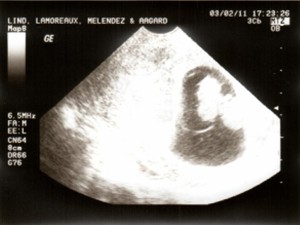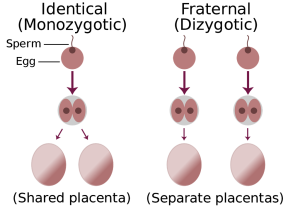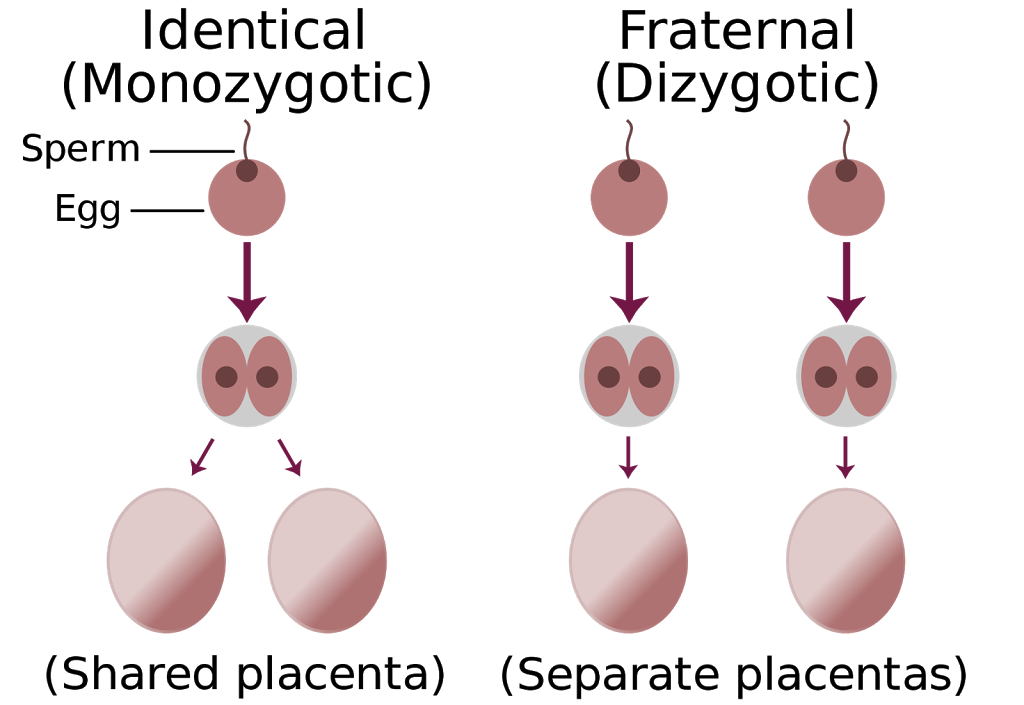Quite a few people lately have asked me to explain the difference between fraternal and identical twins. Now I am by no means a doctor, but since finding myself pregnant with twins I have learned a thing or two about identical versus fraternal.
Identical Twins
Identical twins develop from one egg–fertilized by one sperm–that then splits, creating two babies. Identical twins share one placenta. They are genetically nearly identical and share nearly 100% of the same genes. Identical twins are always the same gender, and have nearly the same features, hair color, eye color, etc.
There are three basic types of identical twins.
 |
|
| My twins at 9 weeks. You can see they have separate sacs. |
Monochorionic-monoamniotic identical twins occur when the egg splits more than 9 days after fertilization. These twins share both a placenta and a sac. This type of twin is pretty rare and extremely risky (at least according to my obstetrician). It only happens in about 30% of identical twin pregnancies. Because they share a sac, there is a high risk of the twins getting tangled up in each other’s umbilical cords. This is of course very dangerous and can result in serious complications.
Monochorionic-diamniotic identical twins occur when the egg splits 4-8 days after fertilization. These twins are much more common, making up about 70% of identical twin pregnancies. This is the type of twin that Thing 1 and Thing 2 are. Mono-di twins share a placenta, but each have their own amniotic sac. While a twin pregnancy is always risky, mono-di twins are much less risky than mono-mono twins since they don’t share a sac.
Conjoined twins usually occur when the egg splits 12 or more days after fertilization.
Twin-to-twin transfusion syndrome is a dangerous condition that can occur only in identical twin pregnancies. Basically one twin “hogs” the placenta, receiving the majority of its nutrients. The result is one twin getting too much and the other twin getting too little. This is extremely risky and dangerous to the lives of both babies. Luckily, I never had to deal with this.
Fraternal Twins
Fraternal twins develop when there are two eggs, fertilized by two different sperm. They each have their own placenta. They can be the same or different genders, and they are not genetically nearly identical.
 |
| the basic difference between identical and fraternal |
And that’s it–the basic difference between identical and fraternal twins.
But wait, you say. Are twins really genetic?
Fraternal twins can be genetic, but only if you’re female. Fraternal twins result when a mother releases two eggs instead of just one at ovulation, which can be a genetic factor passed though the female line. If your mom is a fraternal twin, and you are a female, your chances of having twins are higher than the average person’s. If, however, you are a male, your chances are the same as anyone else’s.
Identical twins have no known genetic link. There are 20 sets of identical twins in your family, you say? Well, science says that’s just a lucky coincidence. Because identical twins are a “fluke of nature” and not something you’re genetically predispositioned to have
Twin Statistics
from the book When You’re Expecting Twins, Triplets, or Quads by Dr. Barbara Luke and Tamara Eberlein
60% of twins are born before 36 weeks gestation.
Approximately 1/3 of all twins are identical.
The natural incidence of twins is 1 in 89 births. However, due to fertility treatments, the instance of twins in the United States is about 1 in 33 births.
Nearly 1/3 of all twins are a result of infertility treatments.
If you have already given birth before your multiple pregnancy, you are half as likely to give birth before 35 weeks as someone who has never given birth before.
Women over age 30 are significantly more likely to make it to at least 35 weeks gestation.
Multiples are usually more mature than singletons of the same gestational age.
The average birth weight for twins is 5 lbs 3 oz.
How Do My Twins Compare?
Because I know people will ask…how do my twins compare to the statistics?
Thing 1 and Thing 2 are not the result of fertility drugs. I’ve done the whole fertility thing before the twins and after the twins. But they happened all on their own.
Thing 1 and Thing 2 were born at 34 weeks 2 days gestation–nearly 6 weeks early.
They spent 17 days in the NICU, mostly learning how to eat and gain weight.
They were born via c-section.
Thing 1 weighed 5 lbs 5 oz and Thing 2 weighed 5 lbs 8 oz.
So to recap–identical, 1 egg. Fraternal, 2 eggs. And that’s basically what separates fraternal and identical twins from each other.
TWIN MOM TIP: Don’t do too much research while you’re pregnant–you’ll just freak yourself out. Just be smart, take care of yourself and your babies, and get all the rest you can. Once they’re born, you’re going to need it!



Great post, Lindzee. My twins were almost the exact same size but they were born at 37 weeks (c-section.) I guess yours were just ready sooner :)<br /><br />They were watching for twin-to-twin and they thought they had it but in the end the difference wasn't too drastic. *phew*